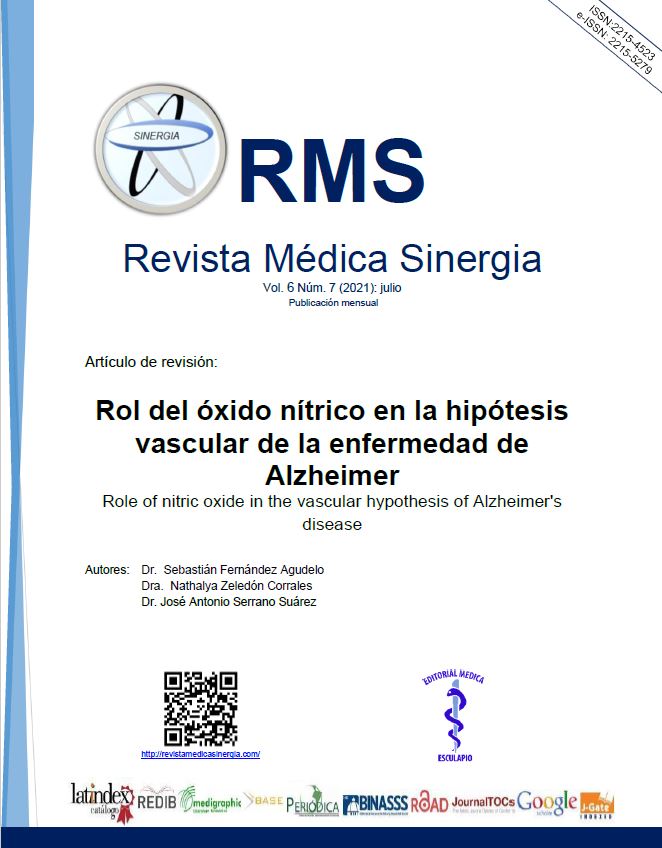Abstract
Nitric oxide plays a fundamental role in the vascular hypothesis of Alzheimer's disease. The three subtypes of the enzyme nitric oxide synthase, responsible for the production of nitric oxide in the body, are involved in the pathophysiology of this disease. First, the decrease in vascular blood flow decreases the activation of the endothelial nitric oxide synthetase enzyme. Second, chronic inflammation resulting from senile plaque formation and microglial activation activates the inducible nitric oxide synthase enzyme. Third, alterations in calcium receptors increase the activation of the neuronal nitric oxide synthetase enzyme. Nitric oxide is also directly involved as it leads to an increase in oxidative / nitro-oxidative stress that alters mitochondrial function and leads to the eventual apoptosis of the cells of the neurovascular unit, causing the progressive cognitive and functional deterioration typical of the Alzheimer disease.
Keywords
References
Iadecola C. Vascular and metabolic factors in Alzheimer’s diseases and related dementias: Introduction. Cell Mol Neurobiol. marzo de 2016;36(2):151.
Lyros E, Bakogiannis C, Liu Y, Fassbender K. Molecular links between endothelial dysfunction and neurodegeneration in Alzheimer’s disease. Curr Alzheimer Res. enero de 2014;11(1):18-26.
Janota C, Lemere CA, Brito MA. Dissecting the Contribution of Vascular Alterations and Aging to Alzheimer’s Disease. Mol Neurobiol. 2016;53(6):3793-811.
Yamazaki Y, Kanekiyo T. Blood-Brain Barrier Dysfunction and the Pathogenesis of Alzheimer’s Disease. Int J Mol Sci. 13 de septiembre de 2017;18(9).
Lourenço CF, Ledo A, Barbosa RM, Laranjinha J. Neurovascular uncoupling in the triple transgenic model of Alzheimer’s disease: Impaired cerebral blood flow response to neuronal-derived nitric oxide signaling. Exp Neurol. 2017;291:36-43.
Kisler K, Nelson AR, Montagne A, Zlokovic BV. Cerebral blood flow regulation and neurovascular dysfunction in Alzheimer disease. Nat Rev Neurosci. 18 de mayo de 2017;18:419.
Asiimwe N, Yeo SG, Kim M-S, Jung J, Jeong NY. Nitric Oxide: Exploring the Contextual Link with Alzheimer’s Disease. Oxid Med Cell Longev. 2016;2016:7205747.
Katusic ZS, Austin SA. Neurovascular Protective Function of Endothelial Nitric Oxide - Recent Advances. Circ J Off J Jpn Circ Soc. 24 de junio de 2016;80(7):1499-503.
Tarantini S, Tran CHT, Gordon GR, Ungvari Z, Csiszar A. Impaired neurovascular coupling in aging and Alzheimer’s disease: Contribution of astrocyte dysfunction and endothelial impairment to cognitive decline. Exp Gerontol. 2017;94:52-8.
Toth P, Tarantini S, Csiszar A, Ungvari Z. Functional vascular contributions to cognitive impairment and dementia: mechanisms and consequences of cerebral autoregulatory dysfunction, endothelial impairment, and neurovascular uncoupling in aging. Am J Physiol Heart Circ Physiol. 1 de enero de 2017;312(1):H1-20.
Yagami T, Koma H, Yamamoto Y. Pathophysiological Roles of Cyclooxygenases and Prostaglandins in the Central Nervous System. Mol Neurobiol. 2016;53(7):4754-71
Di Marco LY, Venneri A, Farkas E, Evans PC, Marzo A, Frangi AF. Vascular dysfunction in the pathogenesis of Alzheimer’s disease--A review of endothelium-mediated mechanisms and ensuing vicious circles. Neurobiol Dis. octubre de 2015;82:593-606.
Toda N, Okamura T. Cigarette smoking impairs nitric oxide-mediated cerebral blood flow increase: Implications for Alzheimer’s disease. J Pharmacol Sci. agosto de 2016;131(4):223-32.
Salmina AB, Inzhutova AI, Malinovskaya NA, Petrova MM. Endothelial dysfunction and repair in Alzheimer-type neurodegeneration: neuronal and glial control. J Alzheimers Dis JAD. 2010;22(1):17-36.
Merlini M, Shi Y, Keller S, Savarese G, Akhmedov A, Derungs R, et al. Reduced nitric oxide bioavailability mediates cerebroarterial dysfunction independent of cerebral amyloid angiopathy in a mouse model of Alzheimer’s disease. Am J Physiol Heart Circ Physiol. 1 de febrero de 2017;312(2):H232-8.
Wang W, Yin J, Ma X, Zhao F, Siedlak SL, Wang Z, et al. Inhibition of mitochondrial fragmentation protects against Alzheimer’s disease in rodent model. Hum Mol Genet. 01 de 2017;26(21):4118-31

This work is licensed under a Creative Commons Attribution-NonCommercial 4.0 International License.
Copyright (c) 2021 Array


